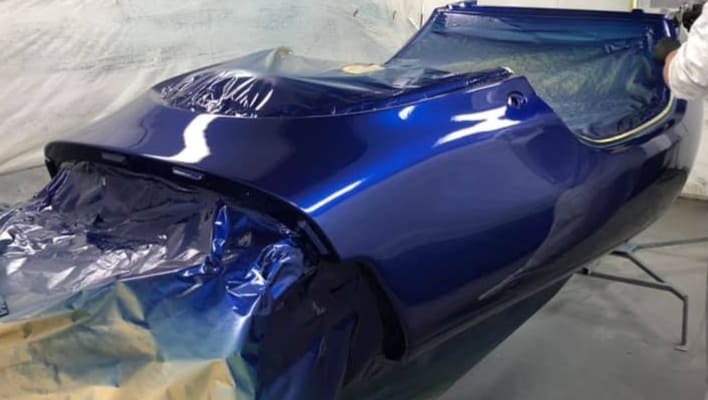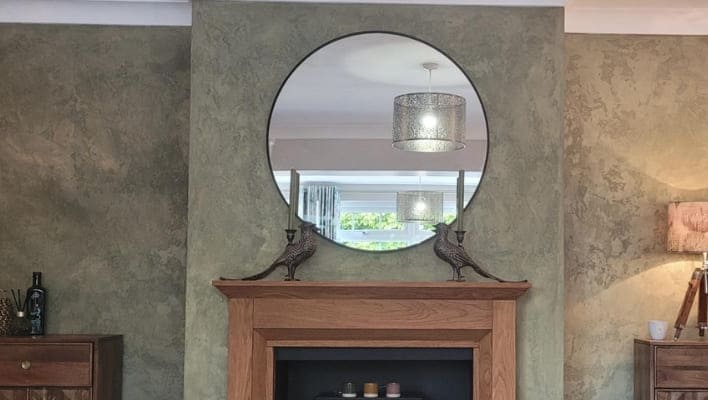Do you think expensive painting sprayers are good enough for achieving a professional paint job? Of course, not! Applying paint in the right way is also an essential part of producing quality results. Most paint sprayers usually require thinning the paint before use. When the paint is too thin, it looks watery and requires additional layers to look good. In contrast, thick paint results in clogged tips, and the paint sprayer fails to atomize it.
Therefore, you must mix the paint in the right proportions to ensure a perfect finish with the spray gun. After doing several painting experiments, we have compiled a comprehensive guide that is easy to read and helps you to clear your mind. So, you have to follow the steps below to learn how to mix paint for a spray gun that will surely give you the results you want.
Table of Contents
- Easy Guide On How To Mix Paint For A Spray Gun
- 1. Requirement for mixing spray paint colors
- 2. Figure out the paint type
- 3. Stir well
- 4. Strain the paint
- 5. Get your test board ready
- 6. The mixing spray paint
- * Paint to water ratio for spray gun (Enamel, Oil based, Latex, Lacquer)
- 7. The mixture in a spray gun
- 8. Cleaning up the painting equipment
- How to mix car paint for a spray gun?
- How do you mix water-based paint for spraying?
- Can you use normal paint in a spray gun?
- Why mix paint with thinner?
- How much thinner do I mix with 1 Litre of paint?
- Can I mix thinner with water?
- Final Words On how to mix paint for a spray gun
- FAQs On How To Mix Paint For A Spray Gun?
- How to mix paint for an electric spray gun?
- What is the auto paint mixing ratio?
- Which type of spray paint do you use for a spray gun?
- How to mix automotive paint for spraying?
- How to thin acrylic paint for sprayers?
Easy Guide On How To Mix Paint For A Spray Gun
1. Requirement for mixing spray paint colors
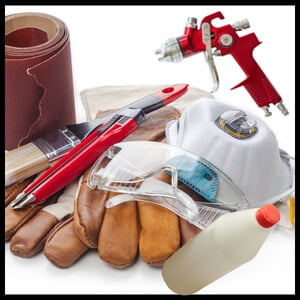
Organize all of the tools you’ll need before you start painting to avoid frustration. Here are the required painting materials:
- Gloves and safety goggles.
- Face mask to keep you safe.
- A clean bucket.
- Paint container.
- Water to dilute the paint.
- Paint thinner for spray gun.
- Paint Strainer for removing all paint impurities.
- Paint spray gun (Corded or Cordless sprayer)
- Paint sprayer tips.
- A test board to determine the consistency of paint.
2. Figure out the paint type

Different paints are designed for various purposes. Choosing the right paint is an important step in mixing paint, as it will affect what kind of thinning agent you will need and how you will mix your paint.
People often ask, How to mix oil based paint for spray gun?
Well, when it comes to oil-based paint, water isn’t the best choice for dilution. A turpentine or mineral spirit would be more suitable.
However, However, water is the best option for thinning liquid for latex paints. You must mix the paint with the right liquid to ensure successful spraying.
3. Stir well
Most people think that they can skip the stirring step at the beginning or casually stir the paint as quickly as possible. It is the wrong approach because you will find most of your paint pigment sitting on the bottom of the container.
Therefore, it is necessary to stir the paint well before adding any thinning agent to the paint container. Otherwise, if you do not stir the paint well before using it, the color and consistency will be changed.
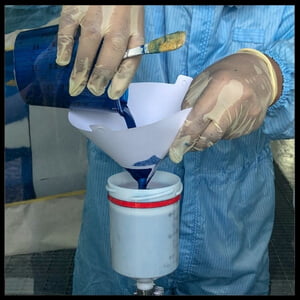
4. Strain the paint
In case, If you forget to stir the paint, it will sit in the container and form clumps. Therefore, make every effort to keep your paint free of lumps so that paint quality will not be compromised.
It is recommended to use strainers to remove all the impurities in the paint.
Plus, you get a smooth mixture of paint that is suitable for spray painting.
5. Get your test board ready
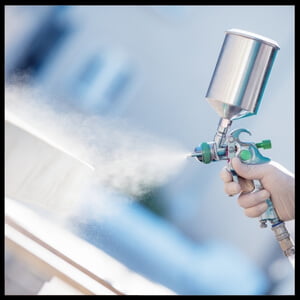
All the spraying paint does not require thinning. Some of the paint can is thin enough to spray without thinning.
In this regard, set up your test board to check the spray quality of the paint before mixing it with a thinner.
When the spray paint comes out flawless and has great coverage, then mixing the paint with thinner is not necessary.
However, if the paint consistency is thick then you will need to thin your paint with one of the recommended thinners. This brings us to the next step.
6. The mixing spray paint
After performing the quality test, you have finally decided to thin the paint. For this purpose, we suggest you follow the manufacturer’s thinning guide on your paint can. Or else, you have to thin the paint by yourself. This will require some time and experimentation, so you should test the spray often.
* Paint to water ratio for spray gun (Enamel, Oil based, Latex, Lacquer)
To start, pour some paint into a clean bucket. If you have selected oil-based paint, then use a quarter cup mineral spirits to thin a gallon of paint.
In contrast, water is an excellent option for thinning latex paint. It is suggested to add quarter cup of water to one gallon of paint to get the good consistency.
Now, if you have found a spray thickness that works, make a note so you can use it next time. After that, mix the paint well and put it in a sprayer (Wagner) to check the spray pattern.
Great! The paint is now ready to spray paint for any project you have planned.
TIP: If you’re in doubt, keep the thicker paint because you can thin it later; however, you cannot thicken the paint again.
7. The mixture in a spray gun
Keep in mind; you cannot obtain a good paint finish and smooth coverage with a cheap paint gun. Therefore, a high-quality paint sprayer (whether HVLP Spray gun or Airless) is just as important as proper paint mixing. At this point, you can pour the diluted mixture into the sprayer to start spraying.
8. Cleaning up the painting equipment
If you want to reuse your painting equipment for years to come, you should clean your sprayer and other equipment once you have finished.
How to mix car paint for a spray gun?
The tips and ratios for mixing car paint:
- The ratios of solvent and water-based metallic paints may vary depending on the product, but liquid metallic paints are mixed in a ratio of 2:1 (2 parts paint to one part thinner), while water-based metallic paints are mixed with 10 percent additives.
- With 2 part acrylic paints, you need both hardener and thinner to obtain the right viscosity. General guidelines suggest a ratio of 2:1 color to hardener with a thinner addition of 10%.
- You should not completely fill up the paint cup attached to the gun, since it makes the paint gun heavy.
- It is also important to ensure that the surface to be painted is clean and free of dust, particles, and dents. Moreover, you should allow the paint to completely dry before you apply a final top coat.
- It’s also a good idea to park the vehicle in a well-ventilated space to ensure that you aren’t affected by the paint fumes.
How do you mix water-based paint for spraying?
To mix water-based paint for spraying, follow these steps:
- Preparation: Mix the paint thoroughly in its container before beginning.
- Dilution: Add water to the paint, and stir it constantly until you reach the desired spraying consistency. Spraying generally requires a 10-20% water/paint ratio.
- Testing: Check the paint’s consistency and coverage on a scrap piece of material.
- Adjustment: If necessary, adjust the paint-water ratio to ensure smooth application.
It is important to keep in mind that the ideal ratio will depend on the paint and the spraying equipment that you use.
Can you use normal paint in a spray gun?
Yes, you can use standard paint in a spray gun, but it’s crucial to ensure the paint’s viscosity suits the gun’s specifications. Some paints may need thinning for proper atomization.
Why mix paint with thinner?
Mixing paint with thinner helps you to achieve the right consistency for paint spraying. It makes the paint flow more smoothly and allows for better coverage.
How much thinner do I mix with 1 Litre of paint?
The ideal ratio of thinner to 1 liter of paint can vary depending on the paint type and specific application. A common starting point is around 10-20% thinner, but always check the paint manufacturer’s recommendations.
Can I mix thinner with water?
It’s generally not recommended to mix paint thinner with water, as they serve different purposes. Water can dilute paint, but it may not work as effectively as the recommended thinner, potentially affecting the finish. Always follow the manufacturer’s guidelines for thinning.
Final Words On how to mix paint for a spray gun
The paint manufacturers usually provide guidelines on how to mix paint for a spray gun to get desired results. So, it is always good to follow the manufacturer’s instructions first and then make your own changes according to your need.
By now, you have learned the art of mixing paint for spray gun. It’s as simple as following the steps and carefully measuring everything out to avoid wasting paint.
Good luck to you!
FAQs On How To Mix Paint For A Spray Gun?
How to mix paint for an electric spray gun?
Add one-quarter cup of water to a gallon of paint and mix thoroughly. After that, test the consistency of the paint using a funnel, and then use a test board to see how it sprays.
What is the auto paint mixing ratio?
Usually, paint can use in two parts, hardener in one part with 10% paint thinner. However, the spray gun setup and air supply may affect the paint to the thinner ratio for spray gun.
Which type of spray paint do you use for a spray gun?
Latex paints are commonly used for spray guns. These paints are made of new synthetic resins that are water-soluble. Plus, quality and reasonable prices make latex paint extremely popular among other types of paint. You can also use other kinds of paint as long as they are thinned and mixed properly.
How to mix automotive paint for spraying?
The process of mixing auto paint in your spray gun is similar to mixing other paint in a spray gun. You can add paint color to the hardener in 2:1 with a 10% addition of thinner and then do a test spray to determine if it’s ready to use.
How to thin acrylic paint for sprayers?
The process of thinning Acrylic paint for sprayer is similar to mixing Latex paint. When you mix latex paint, you use one part water and three parts paint; whereas to mix acrylic paint, you can add a four-to-one ratio of paint to mineral spirits.
It is good not to thin acrylics with water, since they are thinner than latex paints, so they need less quantity of thinner to achieve the desired consistency.

Jennifer Marie
Jennifer Marie is a general contractor with over the years of experience in home remodeling, DIY projects, and commercial painting projects. Her experience includes working with paint sprayers, painting tools, and other painting supplies. You can follow her on Facebook.

